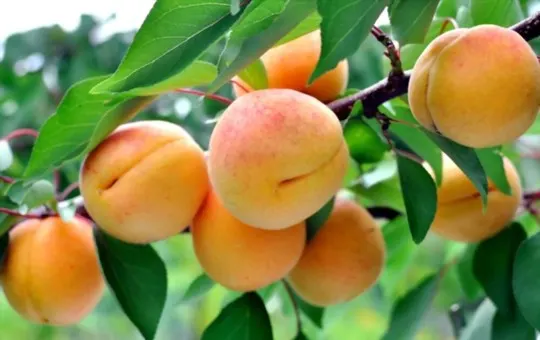When you think of fruity flavors, apricots can often get overlooked.
However, these small orange-yellow fruits are packed full of a unique flavor that is its own and yet somehow familiar.
In this comprehensive guide, we’ll delve into what exactly apricots taste like, why they have become popular around the world, how to tell when an apricot is ripe for picking and more – all so you can add some juicy sweetness to your meals!
What are Apricots?

Apricots are a sweet and tangy fruit that can be enjoyed year-round.
Known for its orange color, apricot has been a popular snack choice among many cultures.
With the added benefit of being an excellent source of vitamins and minerals, apricots are often known as nature’s candy.
From dried to canned versions, these fruits provide a great way to include more nutrients into your everyday routine.
To ensure you get the most out of your apricot purchase, select fruits which are firm and have soft orange skin covering them.
Dried version should feel slightly sticky due to the sugar coating or have visible sugar specs on the fruit surface itself.
Without any perplexity involved in buying them, apricots can give you a delicious good health with even better taste.
What Do Apricots Taste Like?

Apricots have a unique flavor profile that is difficult to describe and varies depending on the ripeness of the fruit.
Apricots are sweet with a slightly tart and tangy flavor.
They have a delicate yet distinct aroma that is hard to miss, with hints of honey and floral notes.
When fully ripe, apricots can have a soft, juicy texture and a taste that is similar to peaches, but with a distinct tanginess that sets them apart.
Some people describe the taste of apricots as a combination of flavors, such as sweet, sour, and nutty, with a hint of floral and honey-like sweetness.
The taste also varies based on the variety of apricots, which can range from very sweet to slightly tangy.
If you haven’t tried apricots before or are unsure about the taste, try getting them from a local farmers’ market when they are in season to experience the best flavor.
You can eat apricots fresh or use them in various recipes such as jams, desserts, and savory dishes.
Factors that Affect the Taste of Apricots

Apricots have a distinctive flavor that can vary depending on several factors.
Here are the key factors that affect the taste of apricots:
- Variety: Different apricot varieties have different taste profiles. Some are sweeter, while others are more tart or floral.
- Ripeness: The ripeness of the apricot can impact its taste. Overripe apricots can taste mushy or fermented, while underripe ones can be sour and lacking in sweetness.
- Growing conditions: Growing conditions such as soil quality, weather, and amount of sunlight can affect the apricot’s flavor. Apricots grown in naturally fertilized soil with plenty of sun tend to be sweeter and more flavorful.
- Season: The time of year that the apricot is harvested can also impact its taste. Apricots harvested in peak season tend to be sweeter and juicier than those harvested out of season.
- Processing: The way the apricot is processed or preserved can also affect its taste. Apricots that have been canned or dried may taste different from fresh apricots.
Knowing these factors can help you choose the right apricot variety and ripeness level to get the taste you are looking for.
So, whether you prefer a sweeter or more tart apricot, keep these factors in mind to ensure a satisfying flavor experience.
1 – Ripeness
When it comes to apricots, taste can vary depending on the ripeness of the fruit.
Unripe apricots tend to be tart, tangy, and slightly bitter, with a firm texture.
Ripe apricots are sweeter, less tangy, and have a softer texture.
They have a delicate, floral flavor with a hint of tartness.
Overripe apricots tend to be softer than ripe ones and have an almost honey-like flavor with a slightly fermented taste.
When selecting apricots, look for firm fruit with a slight give when gently squeezed.
They should have a pleasant fragrance and a uniform orange-gold color without any bruises, blemishes or green spots.
2 – Growing Conditions
Growing apricots require specific conditions, and understanding them can help you appreciate the taste of this fruit better.
Apricots, when ripe, have a soft flesh with a sweet and slightly tart taste.
The flavor is often described as being reminiscent of peaches and plums, with a floral undertone that differs between varieties.
The growing conditions that affect the taste of apricots include:
- Temperature: Apricots thrive in arid climates and need a certain amount of heat to ripen to perfection.
- Soil: Apricots prefer well-draining soil with a neutral pH level.
- Watering: Overwatering can make the fruit taste bland, while under-watered trees can produce smaller and dehydrated apricots.
- Sunlight and Air flow: Apricots need full exposure to sunlight and optimal air circulation for the fruit to develop a robust flavor profile.
Understanding these growing conditions can help you appreciate the efforts that go into cultivating apricots and how each factor can influence the taste of the fruit.
3 – Varieties
Apricots have a unique taste profile that is difficult to describe in a word.
The flavor of each variety of apricot may vary slightly, but generally, apricots taste sweet and tart with subtle floral and honey notes.
Here are some popular varieties of apricots with their unique flavor profiles:
- Blenheim: This variety has an intense sweet-tart flavor with rich, juicy flesh.
- Goldcot: Goldcot apricots have a sweet and tangy flavor with a slightly firm texture.
- Florilege: This French variety has a sweet, honey-like taste with a delicate aroma.
- Rival: Rival apricots are sweet and juicy with a slightly tart finish, making them perfect for snacking.
- Perfection: This variety has a refreshing, fruity taste with a delicate sweetness and aromatic flesh.
How to Eat Apricots?

Apricots are a sweet and juicy fruit with a tang and a delicate aroma.
Learning how to eat apricots can lead to amazing culinary experiences.
Here are the steps to follow:
- Wash the apricots thoroughly to remove any dirt or debris.
- Hold the apricot on both ends and gently twist the fruit to separate the two halves.
- Take out the apricot pit using a knife or your fingertips.
- Eat the apricot halves by biting into the fruit or slicing it to make an apricot salsa, pie or a delicious tart.
Apricots have a distinctive tangy-sweet flavor and a soft texture that makes them perfect to eat fresh or dried.
Apricots can also be preserved as jams, jellies, or marmalades for an extended shelf life.
The fruit’s peel can be candied, and its kernels can be used to make oil that is great for cooking or skin care.
Benefits of Eating Apricots

Apricots are not only delicious, but they are also packed with health benefits that make them worth incorporating into your diet.
Here are some of the benefits of eating apricots:
- Rich in Antioxidants: Apricots are a good source of antioxidants that help protect your cells from damage caused by free radicals. They are particularly rich in beta-carotene, which is converted into vitamin A in the body and plays a vital role in maintaining healthy skin, immune system, and vision.
- Promote Digestive Health: Apricots are rich in dietary fiber, which aids in maintaining a healthy digestive system by promoting regular bowel movements and preventing constipation.
- Support Heart Health: Apricots are low in calories, high in fiber, and rich in potassium, which helps regulate blood pressure and reduce the risk of heart disease.
- Protect Your Eyes: The high beta-carotene content in apricots not only maintains healthy vision but also helps prevent macular degeneration, an eye disease that afflicts many.
Apricots have a distinct flavor profile that can vary from very sweet to slightly tart.
They are juicy and have a texture similar to peaches, but slightly less fuzzy.
If you’re looking for a new fruit to add to your diet, apricots are a great choice.
Conclusion
In conclusion, apricots have a unique flavor profile that is both sweet and slightly tart.
They are juicy, tender, and have a velvety skin that is smooth to the touch.
When ripe, apricots can be eaten raw or cooked and are a delicious addition to many recipes, from jams and jellies to desserts and baked goods.
Apricots are also packed with nutrients, including vitamins A and C, fiber, and antioxidants that can help boost overall health and wellbeing.
Incorporating apricots into your diet is a tasty and healthy way to enjoy a satisfying snack or add flavor to your meals.
Whether you enjoy them fresh, dried, or cooked, apricots are a fruit that you don’t want to miss out on.
So go ahead and grab a handful, and savor the sweet and tangy flavor of one of nature’s most delicious fruits.

What Do Apricots Taste Like? A Comprehensive Guide
Ingredients
- Apricots
- Ingredients from your selected recipes
Instructions
- Select your favorite ingredient from the range available in this article.
- Collect all the necessary items to make the recipe.
- Use the instructions provided to prepare a delicious dish in 30 minutes or less.

Carrie is a food writer and editor with more than 15 years of experience. She has worked for some of the biggest names in the food industry, including Bon Appétit, Food & Wine, and Martha Stewart Living.
As the Editor in Chief of IntroChicago.com, Carrie oversees all of the content on the site. She also manages the team of contributing writers and editors, who help to create delicious recipes, helpful tips, and informative articles that you’ll find on the site.
A native of the Chicago area, Carrie is passionate about all things food. She loves trying new restaurants and experimenting with new recipes in her kitchen. She’s also a graduate of the Culinary Institute of America, so she knows a thing or two about food!
